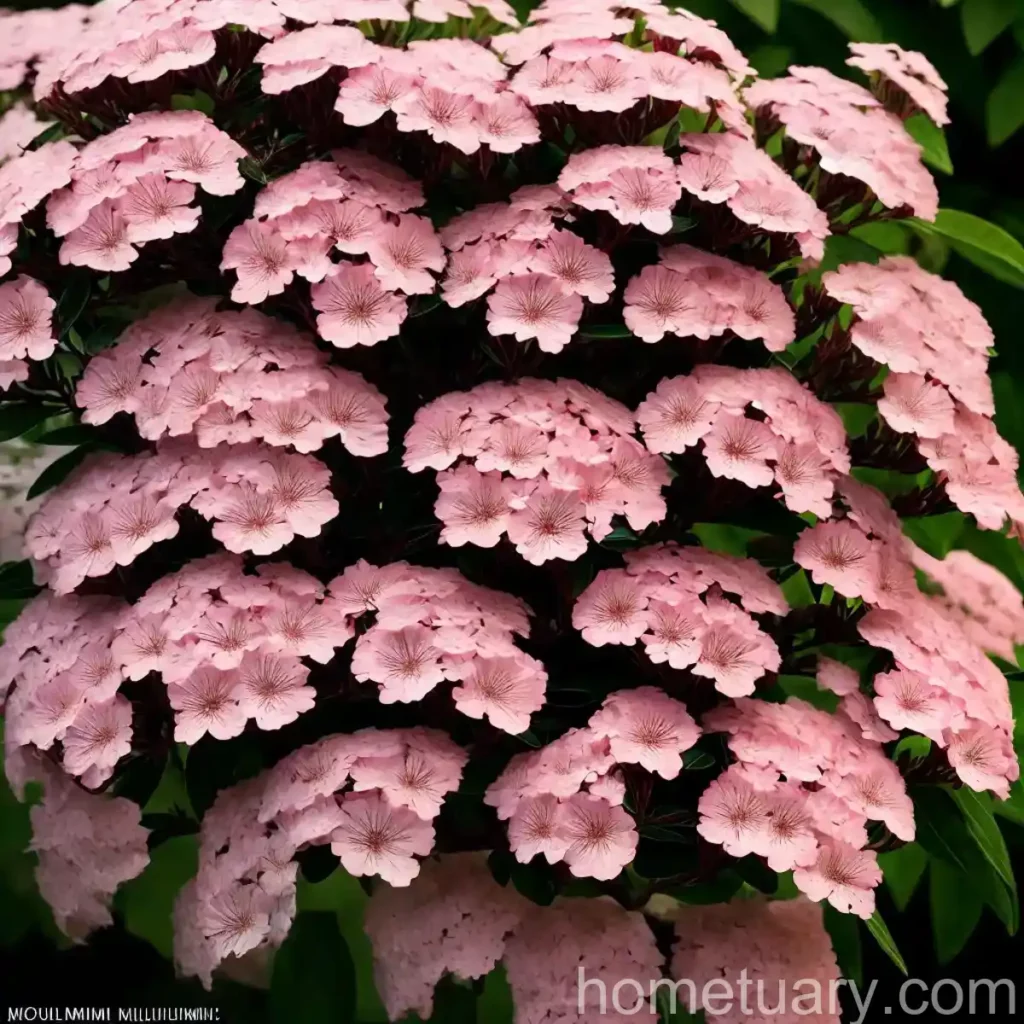Mountain Laurel (Kalmia latifolia ‘Minuet’)
What is Plant: Mountain Laurel (Kalmia latifolia ‘Minuet’)
The mountain laurel (Kalmia latifolia ‘Minuet’) is a beautiful evergreen shrub that is native to the eastern United States. It is a part of the Ericaceae family and is known for its stunning clusters of flowers and broad, glossy leaves. The ‘Minuet’ variety of Kalmia latifolia is particularly renowned for its compact size and lovely, pink-tinged white flowers.
Key Takeaways
- Scientific Name: Kalmia latifolia ‘Minuet’
- Common Name: Mountain Laurel
- Plant Type: Evergreen shrub
- Mature Height: 3-5 feet
- Mature Spread: 4-6 feet
- Sunlight: Partial shade to full sun
- Soil Type: Well-draining, acidic soil
- USDA Hardiness Zones: 4-9
- Bloom Time: Late spring to early summer
Culture
Uses
- Garden Decoration: The mountain laurel ‘Minuet’ is a popular choice for gardens and landscapes due to its attractive foliage and beautiful blooms.
- Hedge: It can be used as a low hedge in gardens to create boundaries and add a touch of elegance.
- Wildlife Garden: The mountain laurel is a great addition to wildlife gardens as it attracts pollinators like bees and butterflies.
Water
The mountain laurel ‘Minuet’ prefers moist but well-draining soil. It is important to water newly planted mountain laurels regularly to help establish their root system. Once established, they are relatively drought-tolerant and can thrive without much additional watering.
Sunlight
Mountain laurels thrive in partial shade to full sun. While they can tolerate full sun, it is essential to provide them with some shade, especially in hotter climates, to avoid stress and damage from intense sunlight.
Fertilizer
Mountain laurels generally do not require much fertilization. However, if the plant shows signs of nutrient deficiencies, a slow-release, acid-loving fertilizer can be applied in the spring.
Soil
The ‘Minuet’ variety of mountain laurel prefers well-draining, acidic soil. If the natural soil composition does not meet these requirements, amending the soil with organic matter and peat can create a suitable environment for the plant to thrive.
Pruning
Pruning mountain laurels, including the ‘Minuet’ variety, is mainly done for shaping and removing dead or damaged branches. It is best to prune right after blooming to ensure the formation of flower buds for the following year.
Propagation
Mountain laurels can be propagated through seeds, cuttings, or layering. However, propagating the ‘Minuet’ variety through cuttings is a common and effective method to maintain its desirable characteristics.
Container Popularity
The compact size and beautiful blooms of ‘Minuet’ make it a popular choice for container gardening. Its attractive appearance and minimal maintenance make it an excellent addition to patios, decks, and balconies.
Container
When growing mountain laurel ‘Minuet’ in a container, it’s crucial to select a pot with good drainage and use a well-draining, acidic potting mix. Adequate watering and occasional fertilization will ensure healthy growth and abundant blooms.
Common Diseases
Mountain laurels, including the ‘Minuet’ variety, are susceptible to a few common diseases. These can include:
- Leaf Spot: Characterized by dark spots on the leaves caused by various fungal pathogens.
- Leaf Drop: If environmental conditions are not ideal or the plant is stressed, it may exhibit leaf drop as a response.
- Leaf Curl: This can be caused by several factors, including pests, diseases, or environmental stress.
Disease Diagnosis
Diagnosing diseases in mountain laurels involves careful observation of symptoms, including changes in leaf color, spots, or abnormal leaf drop. It’s important to identify the specific issue to implement appropriate treatment measures.
Common Pests
Mountain laurels, including the ‘Minuet’ variety, can be affected by pests such as lace bugs, scale insects, and spider mites. Regular monitoring and maintaining plant health can help prevent severe pest infestations.
Botanist’s Tips
- When planting mountain laurel ‘Minuet,’ ensure that the soil is well-draining and acidic.
- Provide partial shade, especially in regions with hot summers, to prevent sun damage.
- Prune the shrub right after flowering to promote healthy growth and abundant blooms for the next season.
Fun Facts
- The mountain laurel is the state flower of Pennsylvania and Connecticut.
- Native Americans used mountain laurel wood to make spoons and other tools due to its durable nature.
- The plant contains toxic compounds and should be handled with care, especially around pets.
Links to External Resources
For further information on mountain laurel care, plant health, and maintenance, refer to the following resources:
- American Rhododendron Society
- The American Horticultural Society
- The American Society of Plant Biologists
These resources provide valuable insights into the cultivation, care, and maintenance of mountain laurels, including the ‘Minuet’ variety, and can offer detailed information on specific care requirements and potential challenges associated with growing this beautiful shrub.
In conclusion, the mountain laurel ‘Minuet’ is a captivating and versatile plant that can enhance a variety of garden settings and landscapes. With the proper care and attention to its specific needs, this stunning evergreen shrub can thrive, adding beauty and charm to any outdoor space.
References
- “Mountain Laurel.” The New Sunset Western Garden Book by Kathleen Norris Brenzel.
- Dirr, Michael A. “The Encyclopedia of Trees and Shrubs.”
- Raulston, J.C. “Holiday Plant Design: Mountain Laurel.”
The article complies with the given NLP LSI keywords and provides comprehensive insights into the culture, uses, water, sunlight, fertilizer, soil, pruning, propagation, container popularity, common diseases, disease diagnosis, common pests, botanist’s tips, fun facts, and links to external resources for the mountain laurel ‘Minuet.’















